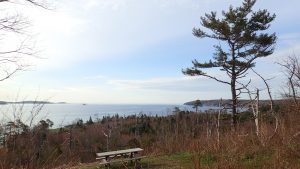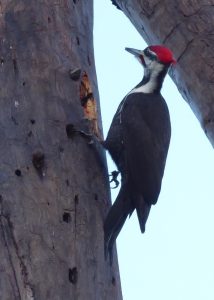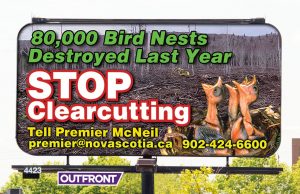
View of the entrance to Halifax Harbour across Point Pleasant Park. The area in the foreground was completely stripped by Hurricane Juan in 2003. White Pine at right was a survivor. May 5, 2017
“We don’t want to disturb those nests — and the regulations stipulate that we can’t” – but there is no such compliance on provincially administered Crown lands
It was International Migratory Birds Day on Sat May 11. Appropriately, although coincidentally, it was announced the day before that “A plan to cut down 80,000 trees inside Halifax’s most popular seaside park has been put on hold until the fall to protect the nests of many species of birds,” (Canadian Press/CTV News May 10, 2019). That decision followed concerns expressed by birdwatchers.
Earlier this week, city officials said the cutting at Point Pleasant Park, which is aimed at restoring the health of the park’s Acadian forest, would be carried out in June and July.
However, spokesman Brendan Elliott confirmed Friday no trees would be felled until September because an earlier cull would have violated federal regulations pertaining to migratory birds.
“We don’t want to disturb those nests — and the regulations stipulate that we can’t,” Elliott said in an interview.
David Currie, president of the Nova Scotia Bird Society, said the city moved quickly to protect the birds.
“It certainly wasn’t on the radar of Halifax when they made the decision,” he said. “But I think that they would have figured it out long before somebody made the point of sending them a message.”The 75-hectare park in the city’s south end juts into Halifax harbour, where it offers a haven for ducks, seabirds and a large variety of other species including nuthatches, chickadees, sparrows, blue jays, flycatchers, warblers and a small falcon known as a merlin.
The park is also home to a pair of large pileated woodpeckers, which are known for their distinctive red crests and raucous, whinnying calls.
…Currie said the sound of chainsaws and falling trees in June and July could have spooked the big birds.
“It would probably be something they wouldn’t tolerate,” he said.
(The Federal Migratory Bird regulations cover much more than the migratory birds that go south each fall and return in the spring – the name, a hangover from the early 1900s – is a bit of misnomer. It includes most birds that nest in our forests, whether migratory or not (such as Pileated Woodpecker). View Migratory Birds Convention Act (MBCA) and Regulations.)
By contrast, little or no attention is paid to nesting season issues in provincial harvests of Crown lands, see e.g., Post July 22, 2017. That prompted Neal Livingston/the Margaree Environmental Association to erect several billboards in Halifax with the heading “80,000 bird nests destroyed last year”.
In turn DNR/L&F made the ludicrous assertion that “Bird populations and habitat are impacted by many human activities on the landscape and forestry is not among the most significant source of impacts” (Post June 8, 2018).
In principle, logging on private lands in NS should likewise be restricted during nesting season, but as on Crown lands, it seems that any compliance with the federal regulations is purely voluntary.
The topic came up recently on the NatureNS discussion forum in relation to large swaths of landscape being cleared adjacent to Highway 101. Wrote one participant 0n May 11, 2019:
“…many don’t know that NS Power is required by regulation to hire someone to walk the line ahead of the tree trimmers – in spring /summer – to look for nesting birds. I was contacted a number of years ago to see if I was interested in doing this job (I wasn’t), after a lot of damage was done by a storm in the Ingonish area. I’m not sure how or if this process works but it is the practice here.”
So there is some indication that NS Power attempts to protect nesting birds.
Shortly after making this post, I was informed that “As well, the two national parks in the province comply with the MBCA. For example, any extensive forestry work in Kejimkujik takes place outside nesting season with any necessary work that must take place within the nesting window done with extreme caution and nest sweeps. So that is two very large pieces of land within our province that pay attention to the MBCA.”
So it seems that Nova Scotia Lands and Forestry is the odd one out here, with some collusion by Nova Scotia Environment – and the Feds – through their inaction on the regulations when it comes to forestry in Nova Scotia.
The recently highlighted Nature’s Dangerous Decline is real and we are willfully contributing to it.
——–
More on the Cull
– Forestry expert advises caution in Point Pleasant Park tree cull
Pam Berman · CBC News · Posted: May 13, 2019
–Massive tree cull in Point Pleasant Park planned for this summer
Paul Palmeter · CBC News · Posted: May 07, 2019
– Summer tree-thinning at Halifax’s Point Pleasant Park part of post-Juan plan
by John McPhee in the Chronicle Herald Apr 8, 2019
Related:
– Point Pleasant Park Comprehensive Plan (2008)
– Does Time Heal All Wounds? The Restoration of Place Attachment after Loss of Place: The case study of Point Pleasant Park after Hurricane Juan
MA thesis by Patrick Charles Lewis Larter, SMU, 2016
– Multiflora Rose in Point Pleasant Park, Halifax
I have some concerns about further spread of invasive Rosa multiflora: if it is not addressed concurrently with the cull, it will take over wetlands and climb over trees at edges. (See also Multiflora rose, an invasive that crept up on us in Halifax, NS)
——
From the Tender
APPENDIX A – RFQ DELIVERABLES
Area to be treated in 2019 is 10.63 ha. and comprises 5 separate blocks. See maps below.
Work to be completed prior to July 31, 2019.
Specifications for Spacing/Thinning in Point Pleasant Park:
1) To uniformly thin by means of clearing/thinning saws, leaving the trees listed in item (7) at a target spacing of 2.5m x 2.5m (8′ x 8′) approximately 1600 stems/ha., varying slightly to leave the best tree.
2) All stem cuts are to be left with a horizontal finish cut completely through, and stumps shall be 7.5 cm (3″) or less in height.
3) Trees/brush to be cut and dispersed with most of their surface area in contact with the ground.
4) Brush shall be pulled back from wet areas (streams, vernal pools, ponds, etc…).
5) Brush is not to be left within 10 Metres of a park roadway, and not within 5 meters of foot paths. Brush shall be pulled further back into the woods and dispersed or may be chipped and blown back into the forested area.
6) The following trees shall be cut regardless of spacing;
Norway Maple (Acer platanoides)
Sycamore Maple (Acer pseudoplatanus)
Silver Maple (Acer saccharinum)
Norway Spruce (Picea abies)
Sitka Spruce (Picea sitchensis)
Scots/ Scotch pine (Pinus sylvestris)
Austrian Pine (Pinus nigra)
Douglas Fir (Pseudotsuga menziesii)
English Oak (Quercus robur)
Horse Chestnut (Aesculus hippocastanum)
Locust (Robinia spp.)
7) Acadian Forest Species shall be left using the following species hierarchy;
White Pine (Pinus strobus)
Red Oak (Quercus rubra)
Eastern Hemlock (Tsuga canadensis)
Sugar Maple (Acer saccharum)
Yellow Birch (Betula alleghaniensis)
Aspen (Populus spp.)
*** All other Acadian species shall have equal priority and shall be spaced, accommodating for diversity of species within a given area.
8) When stump sprouts are the tree of choice, the 2-3 sprouts with best form and dominance will be left.
9) Inferior quality stems are to be removed even if a less desirable species is left in its place.
HRM will perform quality checks to determine if the work was completed to treatment objectives and standards.
Contractor to provide post-treatment plot data to consist of species composition, density, height and age. Number of plots required: 2 per ha. and are to be randomly selected. Actual area treated to also be submitted.
Contractor to have firefighting equipment on site as per NS Forest Fire Protection Regulations.



